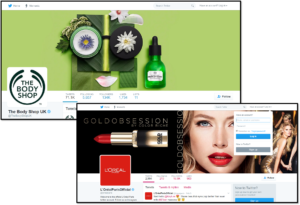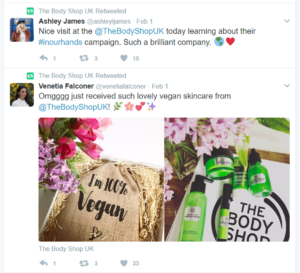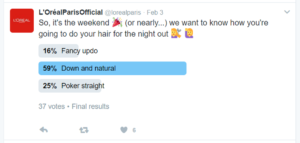I hadn’t done an international marketing post in a while so I thought it could be cool to pair that with some consumer profiling. The L’Oréal Group has a great deal of brands but today, I’m going to focus on L’Oréal Paris and The Body Shop. What I love about comparing and contrasting these brands is that while they both belong to the same group, they originated from two entirely different cultures. L’Oréal Paris originated from the very high-fashion culture while The Body Shop from a very environmentally conscious one, which is displayed in the values they hold and the customers they target. To do these consumer profiles, I chose to look at their Twitter accounts. So, let’s dive in!
The Cover Photo
 Judging by The Body Shop’s cover photo, it’s very obvious that the brand focuses on nature and being green. They clearly show this through the abundance of green shades and all of the flowers and leaves. Besides that, the arrangement is very clean and uncluttered. This coupled with the fact that the only product in the picture is Drops of Youth makes it very clear that the customer is an individual that values their appearance. Instead of covering it up, the consumer tries to maintain their youth and cleanse themselves using natural products.
Judging by The Body Shop’s cover photo, it’s very obvious that the brand focuses on nature and being green. They clearly show this through the abundance of green shades and all of the flowers and leaves. Besides that, the arrangement is very clean and uncluttered. This coupled with the fact that the only product in the picture is Drops of Youth makes it very clear that the customer is an individual that values their appearance. Instead of covering it up, the consumer tries to maintain their youth and cleanse themselves using natural products.
L’Oréal, on the other hand, has a very dark cover photo. There’s a model with flawless, airbrushed skin staring back at you with the reddest lips. To her right are girls partying and to her left, a product by L’Oréal Paris. The entire cover photo resembles a high-end magazine ad. The focus on the gold color and word further highlights the notion. Judging by this cover photo, the brand believes that L’Oréal Paris’ consumers like to go out and doll themselves up.
The Posts
Both accounts do a great job at linking the values to the products that they promote.
 The Body Shop connects with its consumers by showing them that the organization cares about the world. The Body Shop has clearly targeted its consumer well because there are just as much, if not more, tweets by the consumers praising the organization’s products and initiatives than tweets by the company pushing their products. @ashleyljames informs The Body Shop that she was delighted to learn about their Enrich not Exploit campaign. The organization doesn’t just do well in gaining support for its causes but also get quite a bit of praise on its products. Just below @ashleyljames’ tweet is another one by @venetiafalconer, who is thrilled to have gotten vegan skincare. The Body Shop is clearly successful at targeting to the environmental- and health- conscious young adults.
The Body Shop connects with its consumers by showing them that the organization cares about the world. The Body Shop has clearly targeted its consumer well because there are just as much, if not more, tweets by the consumers praising the organization’s products and initiatives than tweets by the company pushing their products. @ashleyljames informs The Body Shop that she was delighted to learn about their Enrich not Exploit campaign. The organization doesn’t just do well in gaining support for its causes but also get quite a bit of praise on its products. Just below @ashleyljames’ tweet is another one by @venetiafalconer, who is thrilled to have gotten vegan skincare. The Body Shop is clearly successful at targeting to the environmental- and health- conscious young adults.
 Contrastingly, L’Oréal Paris focuses on pushing their products. While most of the tweets on the organization’s page are by the organization itself, what I find novel is their little bit of consumer research. With this poll (pictured on the right), not only are they engaging their consumer but they are also gauging their interests. L’Oréal Paris could use this information to suggest products to help the consumers acheive their desired look. Given that most of the posts deal with looking forward to the weekend, L’Oréals customers are young adults whose main focus at the moment is having a good time.
Contrastingly, L’Oréal Paris focuses on pushing their products. While most of the tweets on the organization’s page are by the organization itself, what I find novel is their little bit of consumer research. With this poll (pictured on the right), not only are they engaging their consumer but they are also gauging their interests. L’Oréal Paris could use this information to suggest products to help the consumers acheive their desired look. Given that most of the posts deal with looking forward to the weekend, L’Oréals customers are young adults whose main focus at the moment is having a good time.
All in all, I think that The Body Shop is doing a better job at connecting to its target customer and generating user-generated content. Nonetheless, judging solely on the Twitter accounts, both organizations seem successful in their use of psychographic factors to reach their consumers.
But what do you think? What would you suggest the organizations do to improve their dialogue with the consumers?